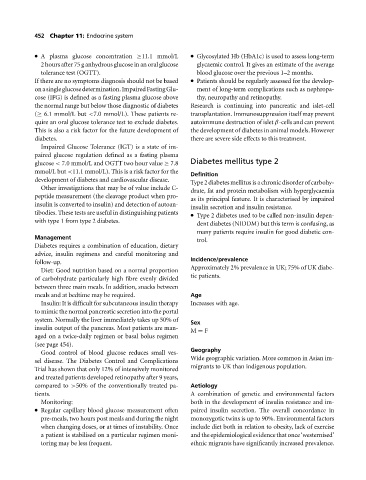Page 456 - Medicine and Surgery
P. 456
P1: FAW
BLUK007-11 BLUK007-Kendall May 25, 2005 8:5 Char Count= 0
452 Chapter 11: Endocrine system
A plasma glucose concentration ≥11.1 mmol/L Glycosylated Hb (HbA1c) is used to assess long-term
2 hours after 75 g anhydrous glucose in an oral glucose glycaemic control. It gives an estimate of the average
tolerance test (OGTT). blood glucose over the previous 1–2 months.
If there are no symptoms diagnosis should not be based Patients should be regularly assessed for the develop-
onasingleglucosedetermination.ImpairedFastingGlu- ment of long-term complications such as nephropa-
cose (IFG) is defined as a fasting plasma glucose above thy, neuropathy and retinopathy.
the normal range but below those diagnostic of diabetes Research is continuing into pancreatic and islet-cell
(≥ 6.1 mmol/L but <7.0 mmol/L). These patients re- transplantation. Immunosuppression itself may prevent
quire an oral glucose tolerance test to exclude diabetes. autoimmune destruction of islet β-cells and can prevent
This is also a risk factor for the future development of the development of diabetes in animal models. However
diabetes. there are severe side effects to this treatment.
Impaired Glucose Tolerance (IGT) is a state of im-
paired glucose regulation defined as a fasting plasma
glucose < 7.0 mmol/L and OGTT two hour value ≥ 7.8 Diabetes mellitus type 2
mmol/L but <11.1 mmol/L). This is a risk factor for the
Definition
development of diabetes and cardiovascular disease.
Type 2 diabetes mellitus is a chronic disorder of carbohy-
Other investigations that may be of value include C-
drate, fat and protein metabolism with hyperglycaemia
peptide measurement (the cleavage product when pro-
as its principal feature. It is characterised by impaired
insulin is converted to insulin) and detection of autoan-
insulin secretion and insulin resistance.
tibodies. These tests are useful in distinguishing patients Type 2 diabetes used to be called non-insulin depen-
with type 1 from type 2 diabetes.
dent diabetes (NIDDM) but this term is confusing, as
many patients require insulin for good diabetic con-
Management trol.
Diabetes requires a combination of education, dietary
advice, insulin regimens and careful monitoring and
Incidence/prevalence
follow-up.
Approximately 2% prevalence in UK; 75% of UK diabe-
Diet: Good nutrition based on a normal proportion
tic patients.
of carbohydrate particularly high fibre evenly divided
between three main meals. In addition, snacks between
meals and at bedtime may be required. Age
Insulin: It is difficult for subcutaneous insulin therapy Increases with age.
to mimic the normal pancreatic secretion into the portal
system. Normally the liver immediately takes up 50% of
Sex
insulin output of the pancreas. Most patients are man-
M = F
aged on a twice-daily regimen or basal bolus regimen
(see page 454).
Good control of blood glucose reduces small ves- Geography
Wide geographic variation. More common in Asian im-
sel disease. The Diabetes Control and Complications
migrants to UK than indigenous population.
Trial has shown that only 12% of intensively monitored
and treated patients developed retinopathy after 9 years,
compared to >50% of the conventionally treated pa- Aetiology
tients. Acombination of genetic and environmental factors
Monitoring: both in the development of insulin resistance and im-
Regular capillary blood glucose measurement often paired insulin secretion. The overall concordance in
pre-meals, two hours post meals and during the night monozygotic twins is up to 90%. Environmental factors
when changing doses, or at times of instability. Once include diet both in relation to obesity, lack of exercise
a patient is stabilised on a particular regimen moni- andtheepidemiologicalevidencethatonce‘westernised’
toring may be less frequent. ethnic migrants have significantly increased prevalence.

